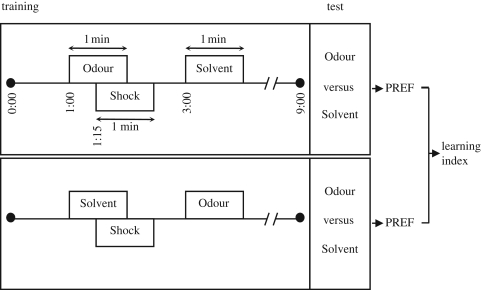Figure 1.
The learning paradigm. One group of flies was trained such that the odour was paired with the shock, and the solvent paraffin oil was presented alone (top); for a second group, we used a reciprocal training regimen (bottom). Each group was then tested for choice between the odour and solvent in a T-maze. For each group, an odour preference (PREF) was calculated based on the distribution of the flies. The difference between the PREF values of the reciprocally trained groups then gives the learning index. Negative learning indices demonstrate conditioned avoidance of the odour. Note that for half of the cases the sequence of events was as depicted (Odour–Shock / Solvent or Solvent–Shock / Odour), whereas for the other half of the cases (not drawn here) the sequence was reversed (i.e. Solvent / Odour–Shock or Odour / Solvent–Shock).

